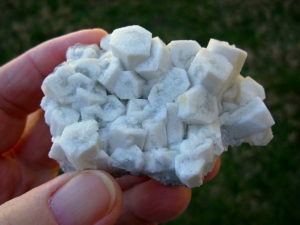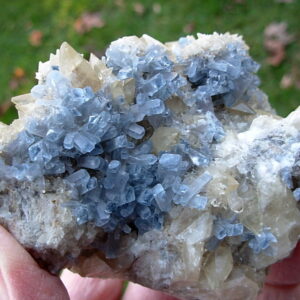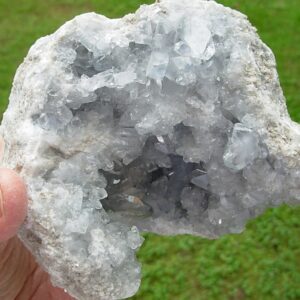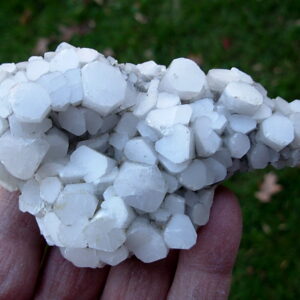Celestine aka Celestite
 Celestine aka Celestite is a mineral consisting of strontium sulfate. The mineral is named for its sometimes alluring light blue color. Celestine is the principal source of strontium which is used in fireworks and metal alloy compounds. Celestine normally occurs as crystals, or may occur as compact massive and fibrous forms. It is routinely found in sedimentary rocks and can be associated with gypsum, anhydrite, or halite. Celestine is found all over the world, usually in small quantities. Pale blue crystal geode specimens are found in Madagascar.
Celestine aka Celestite is a mineral consisting of strontium sulfate. The mineral is named for its sometimes alluring light blue color. Celestine is the principal source of strontium which is used in fireworks and metal alloy compounds. Celestine normally occurs as crystals, or may occur as compact massive and fibrous forms. It is routinely found in sedimentary rocks and can be associated with gypsum, anhydrite, or halite. Celestine is found all over the world, usually in small quantities. Pale blue crystal geode specimens are found in Madagascar.
"Over the years, many localities across the state of Ohio have rewarded collectors with museum quality specimens. However, only a handful of these localities have become true classics in the global realm of mineral collecting. When considering the roster of classic Ohio localities, the Stoneco Inc. Lime City Quarry, noted especially for outstanding honey brown Fluorite crystals and a wide variety of Celestine habits, must inarguably be included. Heavy mineralization throughout much of the quarry, locality unique specimens, typically with two or more minerals, and a general availability of access in the past 50 years have led Lime City to fame among mineral collectors. At one time, the Stoneco Inc. Lime City operation was an ideal locality for club sponsored field trips, as the quarry was famous for providing most visitors with easily obtainable specimens.
Only in the last 5 years has the quarry been forced to regularly turn away collectors, due to ever stiffening mining laws. Unfortunately, this means an end to what at one time seemed a limitless supply of fine minerals. To that extent, specimens from this favorite collecting locality will soon join the ranks of Pugh and Clay Center, two classic Ohio localities where specimens are now only available crushed and by the ton. Further, and unless the quarry is again made available to collectors, old time, quality specimens from Lime City will likely become increasingly hard to come by and quite costly, as has happened with specimens from other classic closed Ohio localities.
Celestine Caves Many outstanding large Celestine groups have been housed in famous museum collections around the world including: The Smithsonian Institution, The AE Seaman Mineral Museum, The Carnegie Mellon Hillman Hall, and The Ecole des Mines in Paris. Most of these pieces came from one of several large cavernous pockets known to local collectors as caves. These caves, which were often large enough for an adult to stand inside, would form in the center of large algal molds up to 30 feet in width and 15 feet in height. In the late-1960's and 1970's and early 1980's, these caves were routinely discovered rewarding collectors with many outstanding specimens.
The typical Celestine crystal found in these caves was a white columnar cloudy crystal with a grayish center, often referred to as a marshmallow Celestine. These columnar crystals were known to grow to as much as 3 inches in length. The specimens below are examples of this Celestine habit. Notice the distinct cloudy white columnar form known to be unique to this locality. Some caves had similar Celestine crystals covered with small scalenohedral tan Calcite. Although the Celestine crystals were typically the same, the tiny Calcite crystals gave these pieces an overall sandy appearance."
Excellent specimens of Celestine are found in the USA. In New York Celestine was discovered in Lockport in Niagara County, by workers digging the Erie Canal. Other finds occurred in Chittenango Falls, in Madison County and in Walworth in Wayne County. Ohio localities are Put-In-Bay on South Bass Island in Lake Erie, Lime City in Wood County, Portage in Wood County, The Pugh Quarry in Wood County and Clay Center in Ottawa County. Pennsylvania localities are the Meckley Quarry in Mandata in Northumberland County and Bell's Mill in Bellwood in Blair County. Michigan localities are the Scofield Quarry and the Newport Quarry in Monroe County. Illinois localities are the Annabel Lee mine, in Hardin County. Western State localities include Texas at Bull Creek in the town of Austin in Travis County and California in Death Valley in Inyo County.
Information from “Tribute to an Ohio Classic: Stoneco Inc. Lime City Quarry, Wood County, Ohio by Joseph W. Vasichko, Vasichko Minerals, Wooster, Ohio” http://www.rockmanjoe.com/Limecity.html



